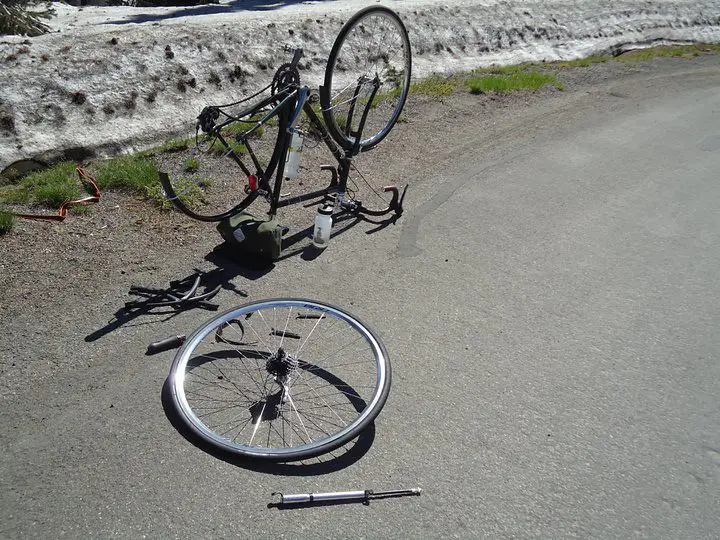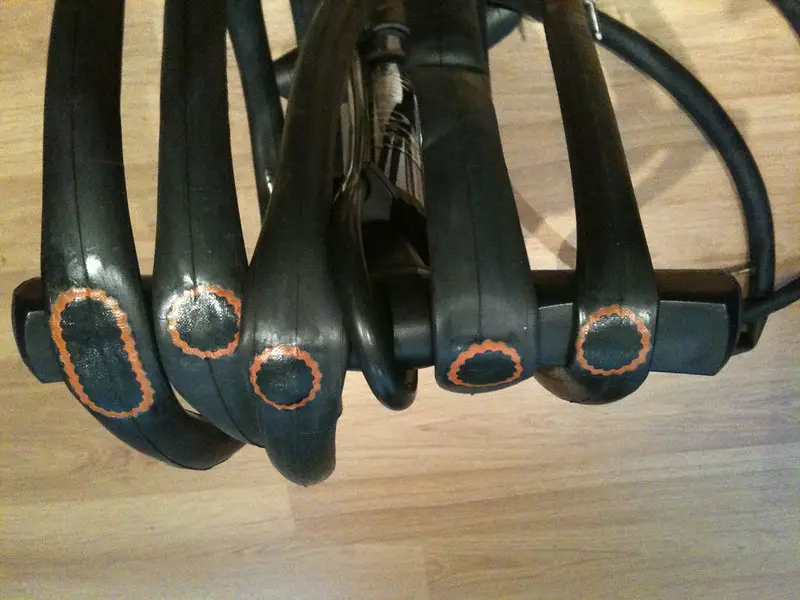It is inevitably going to happen despite it being every cyclist’s worst fear. The dreaded flat tire! No matter the lengths you go through to protect your tires and avoid flats. This is a great time to head to your local bike shop and grab yourself a new tube, or better yet grab yourself a bunch to have replacements on hand. But what if your local bike shop is out of your exact tire size?
Can you use a smaller or bigger inner tube than the tire?
If you use the same diameter inner tube as your rim diameter, the width of the inner tube can be slightly smaller or larger than your tire width. For example, you can use a 622-28 inner tube with a 622-35 tire, even if it is smaller in diameter You can also use a 622-35 inner tube with a 622-28 tire, even if it is wider in diameter. The difference should not exceed 10 mm. If the inner tube is too narrow, it may burst when fully inflated. If it is too wide, it may get pinched easily in the process of mounting and it may not provide sufficient support.
Successfully using a narrower or wider inner tube than the tire means staying within a close margin. The closer to the size of the tire, the better. Ideally, you would use a tube that is the exact size but if no other option is available to you a narrower or wider tire will work in a pinch.
Electric bikes built for everything and priced for everyone. Shop Rad Power Bikes, America's #1 electric bike brand. Get out. Go further. Ride Rad.
I have personally used a narrower inner tube than my tire when I got a bad puncture once and was unable to source a new tire. Thankfully, my friend had an inner tube handy that was just a bit too small for mine, but it got me through an entire 125-mile tour without any problems.
Using a Narrower Or Wider Inner Tube Than The Tire
As mentioned above, this is possible. That being said, it is in your best interest to stay close to the size indicated on the tire. If the difference is too great it can lead to issues that could potentially lead to premature flats.
Whether using an inner tube that is narrower or wider than the tire, it is going to be a pretty straightforward process. You will use it just like you would use one of the correct sizes. A narrower inner tube will fit right into the tire, whereas a wider one may need some coaxing.
When using one that is wider, it is a great idea to ensure that the tube itself is not bunching up and folding onto itself. That can lead to friction against itself and create failure, leading to a flat.
Another thing to watch out for is that the wider tube does not get stuck in the bead of the tire, which can lead to a pinch flat or even the tire popping off the rim.

Pros And Cons Of Wider And Narrower Inner Tubes
Despite a wider or narrower inner tube not being the ideal solution, there are some pros and cons to having either a wider or narrower tube. Read on below to find out about some of these.
Pros and Cons of Wider Inner Tube
Pros:
- The tube is not inflated to its upper limit when using a wider one. Therefore the rubber is not fully stretched out meaning it is thicker. This extra thickness can help to reduce flats and make for a more resilient inner tube.
- When using a narrower tube there is more stress than normal around the valve area. On a wider inner tube, this is not the case making it less likely for there to be a failure near the valve.
Cons:
- Wider tubes can fold over themselves when stuffed into a tire that is smaller than its recommendations. This can lead to rubbing and friction that will degrade the tube faster and causing it to fail more quickly.
- Another common problem with tubes that are wider than the tire is they can get stuck in between the tire bead and the rim. This can cause a pinch flat on the tube but can also blow the tire off of the rim. When using a wider tube be sure that the tube is seated properly in the tire and the bead is locked into the rim especially during inflation.
Pros and Cons of Narrow Inner Tube
Pros:
- Easier to install than a wider inner tube. There is no fussing or coaxing necessary as a narrower inner tube will easily fit into a tire of a larger size.
- Narrower tubes are going to be a lighter weight option when compared to tubes of the correct size or wider. This means that if you are worried about rotational energy or a few grams then using a narrower tube can save a tiny bit of weight.
Cons:
- Using a narrower tube means that when it is fully inflated to the tire size then it is over-inflated. This leads to more stress on the rubber and it is thinner than it should be. This added stress to the inner tube means that it will not last as long as one that is the correct size for your tire.
- Overinflation not only means more stress on the whole tube but especially around the valve. When using a narrower tube overinflation creates a slight indentation right around the valve area that can be felt by the rider during every revolution. This can lead to comfort issues from the bumpiness added to the ride from this depression.
- A narrower tube that is over-inflated is prone to flats as the added stress can cause the area around the valve to fail. It is also more likely to get punctured by road debris or thorns as the rubber is much thinner than it would be when using a tube of the correct size or wider one.
Related Questions
Do I Need A New Bike Tire Or Just A Tube?
If your tires go flat from a puncture or a pinch flat then you generally only need to replace or repair the inner tube. Tires only need to be replaced if there is excessive wear, big cuts, or sizable gouges in them.
Another thing to look out for is threads showing on the tread or sidewall of the tire. Whenever replacing an inner tube it is a good idea to inspect the tires for excessive wear or damage and replace them only if needed.
Is It Worth Repairing Inner Tubes?

Carrying an extra inner tube or tubes is considered by most to be the best. However, it is not a bad idea to carry around a patch kit as well.

Many cyclists will say that replacing the tube is better than patching unless of course, you do not have a spare tube handy. This is because a patch adds a tiny bit of weight and can slow you down in the long run. Patches are also notoriously unreliable and can spring a leak at any time.
Do New Bike Tires Come With Inner Tubes?
New bike tires are rarely sold with inner tubes. If looking into buying new tires for your bike be prepared to buy new inner tubes to go inside of them.
If you are buying the same size tires it is perfectly reasonable to transfer the old tubes into the new tires but most mechanics and cyclists will tell you that replacing the tubes at the same time is a good idea.
Many cyclists will use one of the old tubes as a spare with their flat kit.
Should I Carry A Flat Repair Kit?
Yes! Almost every cyclist with a fair amount of experience will tell you not to leave home without a flat repair kit.

I personally always carry two tubes, tire levers, CO2 cartridges, and a CO2 pump. Some flat kits will differ with maybe a manual pump over a CO2 pump or even a patch kit but you should never leave home without the proper tools to fix your flat on the go.
Conclusion
No matter how hard you try to protect yourself from it a flat tire is bound to happen while on your commute.
While seeking a replacement at your local bike shop you may find they are out of stock of just the right size. However, do not fret as an inner tube that is narrower or wider than your tire size could be a suitable short term fix. Using the tips laid out above a mismatched inner tube could fix the problem and at least get you to where you are going or home.
Ideally, it is best to use the correct size for a long-term fix but do not be afraid to use one that is narrower or wider if there is nothing else available to you.
Some of the best advice we can offer to you is to be sure to buy a bunch of inner tubes in your size and keep them at home. This will ensure that you always have the correct size on hand when you need them.
Happy Pedaling!
